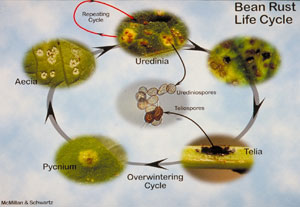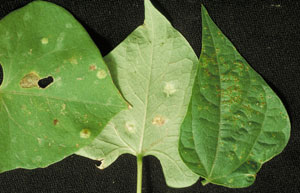by H.F. Schwartz, J.R. Steadman and R.M. Harveson* (3/13)
Quick Facts…
- Wet, cool weather during flowering and pod formation is conducive to rust epidemics.
- Fungus spores are windblown between and within bean fields.
- Throughout the growing season, a disease cycle may be repeated every 10 to 14 days under favorable conditions.
- Disease management practices include crop rotation, soil incorporation of bean debris, planting during recommended dates, planting resistant varieties, and timely spraying of fungicides.
Rust is an important disease that affects dry beans in eastern Colorado, western Nebraska and surrounding regions. The disease is caused by the fungus Uromyces appendiculatus, which has caused periodic epidemics in this region during the last 50 years. Recent losses from the disease have exceeded 50 percent in some areas.
Disease Symptoms
Rust symptoms initially appear as small yellow or white slightly raised spots on upper and/or lower surfaces of leaves. These spots enlarge and form reddish-brown or rust-colored pustules that are about 1/8 inch in diameter and contain thousands of microscopic summer spores (urediniospores). Spores (fungus seeds) are readily released from the pustule and give a rusty appearance to anything they contact. Rust can be distinguished from other leaf spots in that these spores rub off onto your fingers, while blights and bronzing do not.
Pustules may be surrounded by a yellow border. Severe infection may cause leaves to curl upwards, dry up, turn brown and drop prematurely. A severely damaged bean field often looks like it has been scorched. Pod set, pod fill and seed size can be reduced if early infection is severe. Green pods, and occasionally stems and branches, also may become infected and develop typical rust pustules. However, bean rust is not seed-borne.
Near the end of the season, pustules undergo a subtle change and form brownish-black winter spores (teliospores) that signify the end of the current infection cycles. This overwintering phase has been confirmed to occur or contribute to rust epidemics in eastern Colorado and western Nebraska and Kansas. It is a factor in northern states such as North Dakota and Minnesota by producing sexual stages the following season.
Source and Spread
The two potential sources of rust inoculum (spores) that initiate an epidemic are locally overwintered teliospores and air-borne urediniospores blown in from distant bean fields. Rust spores, especially teliospores, overwinter in bean straw in some regions of the United States. The teliospores germinate in the spring and produce basidiospores that can be blown onto volunteer or new bean plants in early spring.
Bean plants become infected by basidiospores that initiate specialized types of pustules called pycnia (hellow to yellow brown) on the upper surface and aecia (white) on the lower surface of leaves. These pustules last for a few days and are difficult to detect. Spores (aeciospores) from these pustules eventually infect other bean leaves and plants, and the characteristic reddish-brown repeating stage develops.

Figure 1: Life cycle of bean rust (Uromyces appendiculatus). |
The initial appearance of rust in our region occurs in midsummer, apparently after urediniospores from local or distant bean
production regions are transported here by wind currents and deposited on leaves. These spores germinate and enter a leaf through the plant stomates (breathing pores). They develop within the host tissue to form a small white spot or blister in five to seven days and mature reddish-brown pustules in 10 to 12 days.
Local wind currents transport the powdery spores and spread the disease from the initial infection points (foci) to other leaves, plants and fields. The rate and extent of secondary spread depend on the volume of spores present, varietal susceptibility and weather conditions in the region.
Factors Favoring Epidemics

Figure 2: Developmental stages of a rust urediniospore on a bean leaf surface. |
Rust development is favored by cool to moderate temperatures (65 to 85 degrees F) with moist conditions that result in prolonged periods of free water on the leaf surface for more than 10 hours. Weather conditions during late July and August usually are the most favorable because of cooler nights. Repeating disease cycles may occur at 10- to 14-day intervals under favorable conditions.
The earlier the plant becomes infected during its development, the greater the chance for yield loss. Anything that delays plant maturity, such as late planting, herbicide damage, excess nitrogen or hail damage, may increase the potential for significant yield loss in the event that a rust epidemic occurs. This potential also may be increased by planting on or adjacent to old bean ground.
Rust Management
No single control or disease management measure prevents rust fungus infection. Integrate the following management practices to provide long-term and reliable protection for the crop.
Cultural practices such as crop rotation (two to three years) and soil incorporation of bean debris remove potential sources of rust spores, as well as bacteria causing bacterial blights. It also is important to plant during recommended periods (May 25 to June 15 in eastern Colorado and Wyoming and western Nebraska and Kansas) to reduce late-season exposure to high levels of the pathogen.
Sprinkler irrigation should be timed so that foliage can dry before darkness if possible to avoid prolonged environmental conditions favorable to bacterial diseases and rust.
Many older bean varieties are susceptible to rust. Under severe rust pressure, their productivity will depend on the timely use of fungicides. Some rust-resistant varieties now are available for many market classes including pinto, great northern, small white, red kidney and black beans. However, these new varieties may have limited availability and be susceptible to other disease and insect pests.
Rust-resistant pinto varieties may yield nearly 200 percent more than susceptible varieties when exposed to severe rust epidemic conditions. However, the value and stability of this resistance has been affected by pathogenic variability of the fungus.
University and private varietal improvement programs are searching for new sources of resistance that may be more effective and longer lasting. The value and utility of current varieties with resistance can be extended by integrating them with other control measures such as crop rotation, debris incorporation, planting date, and limited use of protectant and systemic fungicides.
If coverage is thorough, some fungicides can prevent or reduce rust infection if applied early in the season before the epidemic becomes severe. Apply fungicides in at least 5 gallons of water per acre to thoroughly contact plant foliage. It is advisable that spreader sticker agents be applied with the fungicide.

Figure 3: Rust pycnia, aecia and uredinia pustules (left to right). |
Monitor plants frequently during blossom and early pod development, especially during the first set, for initial rust signs at a rate of one to a few pustules per plant. Infections that occur at or after pod bump and stripe seldom cause economic loss. Effectiveness and economic benefit of fungicides depend on application before the epidemic becomes established. Sprinkler systems and frequent rains provide favorable conditions for rust development and may wash protectant fungicides off leaves before they can inhibit rust spore germination.
Protectant fungicides include chlorothalonil and maneb formulations; and systemic fungicides include Endura, Folicur, Headline and Quadris formulations.
Consult local Colorado State Extension, Experiment Station and bean industry personnel for updated fungicide and other rust management recommendations.
*H.F. Schwartz, Colorado State University Extension plant pathologist and professor, bioagricultural sciences and pest management; J.R. Steadman and R.M. Harveson, University of Nebraska-Lincoln. 9/99. Portions are from regional extension publication 562A, Dry Bean Production and Pest Management by H.F. Schwartz, M.A. Brick, R.M. Harveson and G.D. Franc. Revised 5/11.
Go to top of this page.





